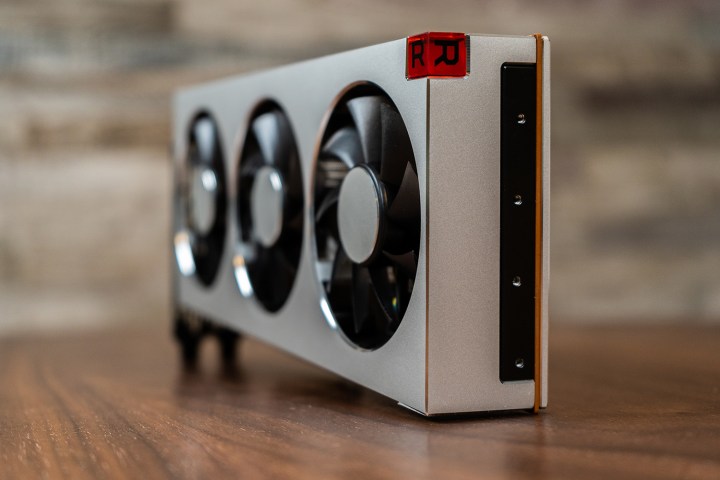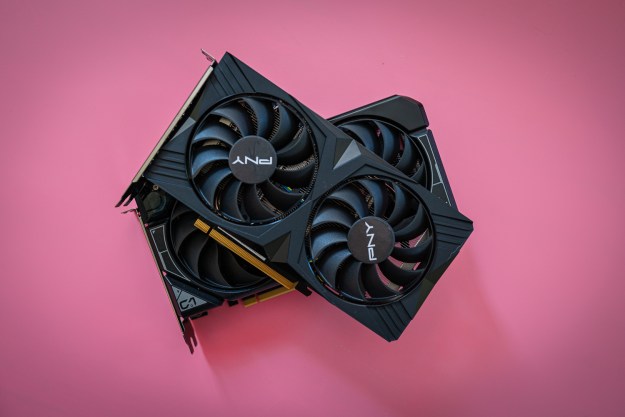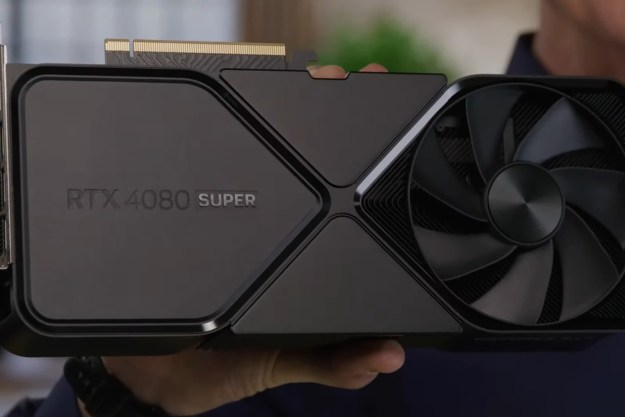Nvidia’s RTX graphics cards are everywhere you look, whether in desktops or laptops. Ray tracing controversies aside, they’re powerful cards. But AMD has powerful cards of its own.
The AMD Radeon VII is a true successor to the Vega 64 in more ways than one. It’s built on the second-generation, 7nm Vega architecture, and it’s the first high-end graphics card AMD released since its Vega predecessor. There’s no question that it’s more powerful than that card, but how does it fare against its main competition? We pitted the AMD Radeon VII versus the Nvidia RTX 2080 to find out.
Note: Both the Radeon VII and RTX 2080 are end-of-life and are no longer available for sale. Nvidia replaced its card with the RTX 3080, while AMD will replace its card with the upcoming RDNA2 line.
Performance
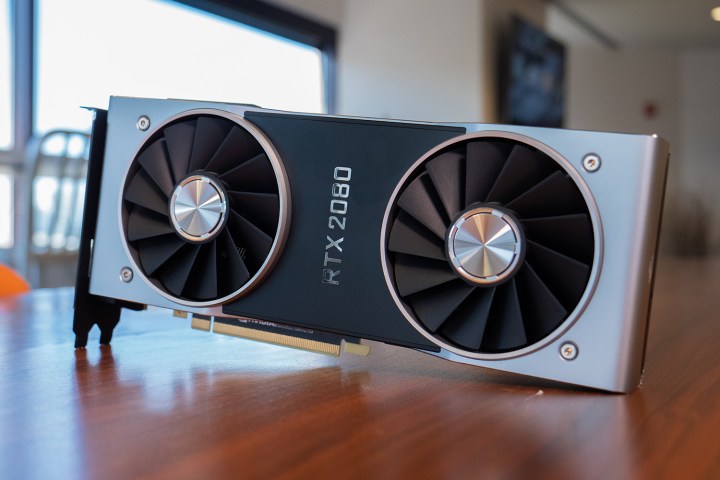
AMD’s Radeon VII might be a successor Vega architecture, but its design is quite different than its predecessor. The 7nm process makes the GPU itself smaller and facilitates a shrinking of the whole die from 495mm² on the Vega 64, to 331mm² with the Radeon VII. It’s fitted with four stacks of second-generation high bandwidth memory (HBM2) and runs at a much higher frequency than the first-generation Vega cards.
Nvidia’s RTX 2080 is built on Nvidia’s Turing architecture and is paired with GDDR6 memory that runs at a higher speed than the 10-Series Pascal graphics cards. Turing cards improve performance over their last-generation counterparts by increasing the number of CUDA cores and memory speed. Clock speeds remain much the same when running at stock, though automated 20-Series overclocking does aid performance.
Nvidia and AMD use different designs in their graphics cards manufacturing, so the specifications aren’t necessarily directly comparable, but here they are nonetheless:
| AMD Radeon VII | Nvidia RTX 2080 | |
| Architecture | Vega 20 | Turing |
| Node process | 7nm | 12nm |
| Die size | 331mm² | 545mm² |
| Transistor count | 13.2 billion | 13.6 billion |
| Processor cores | 3,840 stream processors | 2,944 CUDA cores |
| Base clock | 1,400MHz | 1,515MHz |
| Boost clock | 1,750MHz | 1,710MHz |
| Memory | 16GB HBM2 | 8GB GDDR6 |
| Memory interface | 4,096-bit | 256-bit |
| Memory bandwidth | 1,000GB/s | 448GB/s |
| TDP | 300w | 250w |
| Price | $700 | $700 |
To see how these cards performed head to head, we fitted them to our gaming test bench that’s running an AMD Threadipper 1950X (in game mode) and 32GB of memory. In each case, we ran the latest drivers that were available at the time. For the Radeon VII, they were pre-release drivers.
In 3DMark Fire Strike, the results were impressive for both cards, but noticeably more so for the Radeon VII. AMD’s new card was expected to perform better against Nvidia’s GPUs at higher resolutions, but in the base Fire Strike test, it not only beat out the RTX 2080 but performed comparatively well to the RTX 2080 Ti, a much more expensive GPU.
In gaming benchmarks, we saw similar results at 1080p, with the Radeon VII delivering frame rates in Battlefield V at both Medium and Ultra settings well above 100 frames per second, beating out not only the RTX 2080 but the 2080 Ti as well. The always-taxing Deus Ex: Mankind Divided proved more challenging, but the Radeon VII still pulled ahead of the 2080 and 2080 Ti with an average 90 fps when on High, and 86 fps on Ultra settings.
At 1440p, the 2080 Ti takes its rightful place at the head of the pack, but Radeon VII takes an even greater lead over the 2080 and makes its predecessor, the Vega 64, look very much like the last-generation card it is.
When we increase resolutions to 4K, all of the cards struggle to maintain 60 fps or more in Battlefield V. Only the 2080 Ti manages it in Deus: Ex at Medium settings, but the Radeon VII remains out in front of the 2080 in all cases.
The RTX 3080 will likely beat both cards handily. A Digital Foundry analysis of Nvidia’s flagship showed a 1.8 times performance increase compared to the 2080. Although the Radeon VII beat the 2080 in a few of our tests, Nvidia will pass the card up soon, at least until “Big Navi” cards hit the market.
Features

As powerful as Nvidia’s RTX graphics cards are, Nvidia spent much of the launch event talking about new features rather than performance. Ray tracing and deep learning super sampling (DLSS) — made possible with onboard RT and Tensor cores, respectively — were big news. While in late 2020, they still aren’t supported by many games, the numbers continue to grow. In some cases, they can have a dramatic impact on games.
Ray tracing makes certain games look prettier, albeit with a big performance cost, and DLSS shows signs of making games both look better and run faster.
Although AMD does have functioning ray tracing in the form of Radeon Rays using the Vulkan API, that’s not a technology that is implemented in any games at this time, and AMD hasn’t made it viable with the Radeon VII. Nor is DLSS available, though AMD has suggested that its cards’ general compute units are capable of something similar. Furthermore, it may even implement it in the future using Microsoft’s open standard, DirectML. Proper ray tracing is coming in AMD’s new RDNA2 cards.
Both cards support different frame syncing technologies out of the box. Nvidia’s RTX 2080 supports its bespoke G-Sync, which is only available on compatible monitors. AMD’s Radeon VII supports FreeSync and FreeSync 2, which are only available on compatible monitors, though they do tend to be cheaper and more plentiful than their G-Sync counterparts. Nvidia supports FreeSync displays that are G-Sync compatible, too.
Both cards support the full gamut of gaming APIs, including DirectX11, DirectX12, OpenGL, and Vulkan.
Nvidia’s RTX 2080 also supports SLI via NVLink for multiple GPUs. AMD has said that it doesn’t plan to offer its traditional multi-GPU technology, Crossfire, with the Radeon VII. However, both Vulkan and DirectX12 have support for multiple graphics cards as an open standard known as MGPU, so it may be that if supported by games (like Strange Brigade), two Radeon VII cards could be run in tandem using that technology.
Compatibility and price
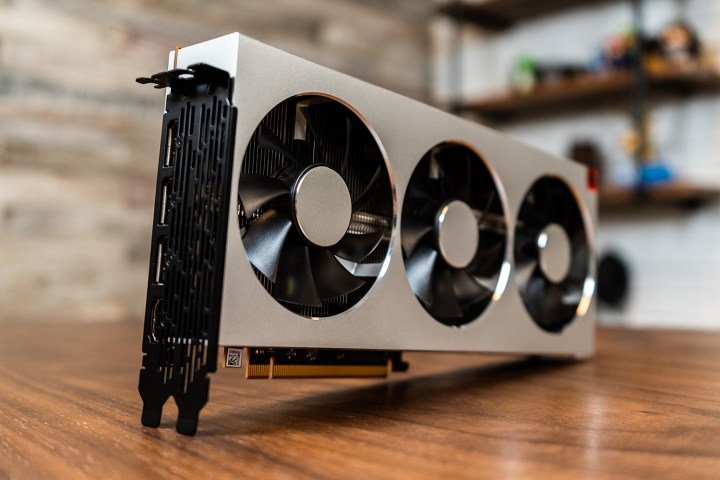
Nvidia’s RTX 2080 launched with a Founders Edition priced at $700, but you’ll be lucky to find a card at that price now. With the impending release of RTX 30-series GPUs, stock is light for Nvidia’s last-gen cards. We found a few cards for around $900, with some going up to $1,300 or more. The secondhand market is better, with third-party cards priced around $500.
The AMD Radeon VII launched with a price tag of $700, but as it is now end-of-life, it’s hard to find anywhere at anything close to reasonable.
When it comes to compatibility, you’ll want a motherboard that supports PCI-Express 3.0 x16 to take full advantage of both cards. If your system has a PCI-Express 2.0 x16 or PCI-Express 3.0 x8 slot instead, both cards should still work, but you may see a small performance lapse due to bottlenecking.
Power requirements for these cards are reasonably steep, but the Nvidia GPU isn’t quite as demanding. It requires around 250 watts of power and cooling potential when in use, while the Radeon VII is rated at 300 watts. You want at least a 600-watt PSU if you’re running the RTX 2080 or a 700-watt one for the Radeon VII.
AMD raises its game
It’s been a long time since AMD legitimately competed with Nvidia at the top of the graphics card market. The Radeon VII isn’t quite strong enough to be a direct competitor for the likes of the RTX 2080 Ti, especially at higher resolutions, but it’s not far off that. At a $700 asking price, it’s priced competitively enough with the RTX 2080 that Nvidia raised its game in 2019 to stay ahead. We’ll get to that in a moment.
Our testing isn’t exhaustive, but it suggests that the Radeon VII will be a more capable card than the RTX 2080 in a number of games and at most resolutions and detail settings. It may be a little more power-hungry, but the newly shrunk GPU and the massive amount of high-speed memory make it one of the most exciting graphics cards available today.
While AMD hasn’t outwardly confirmed it yet, reports in August 2019 claimed that the Radeon VII had already reached the end of its product life. Instead, AMD’s “Big Navi” GPU, which builds upon the 7nm+ process node and RDNA 2 architecture, will most likely take its place on its arrival. It’s tough to find Radeon VII in stock whether you’re looking at retail stores or online, but since it’s mostly used for desktop computers and workstations, the replacement will meet your needs.
Nvidia strikes back
Nvidia’s RTX 20-Series cards had a reputation for providing the best graphics for gaming, and boost PC gaming features to console-like levels, but Nvidia wanted to offer something even better. In July 2019, Nvidia one-upped themselves by producing their RX 20-Series Super cards. Their new Super lineup includes the RTX 2080 Super, the 2070 Super, and the 2060 Super.
A suitable replacement for the 2080 is the 2080 Super. Common with graphics cards, it was superseded a year later by Nvidia’s RX 30-Series cards. Based on Ampere architecture, Nvidia’s RX 30-Series cards were launched in September 2020. If you want to upgrade to the most powerful graphics cards available, you’ll want to check out the impressive specs of the RTX 3080 and 3090.
Editors' Recommendations
- Nvidia RTX 50-series graphics cards: news, release date, price, and more
- 10 best graphics cards of 2024: finding the best GPU for gaming
- Nvidia is the ‘GPU cartel,’ says former AMD Radeon manager
- The Nvidia RTX 4080 Super just trounced AMD
- This underrated AMD GPU beats the RTX 4070 Ti Super


